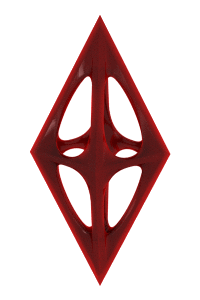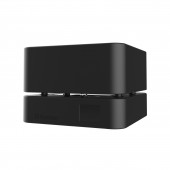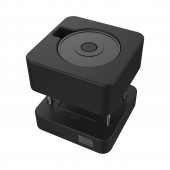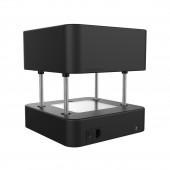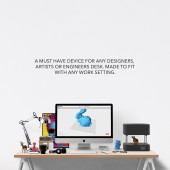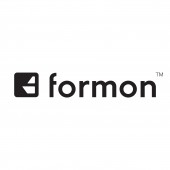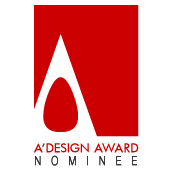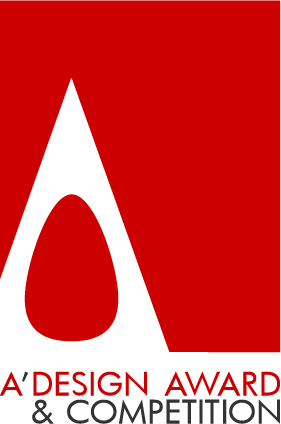Formon Core Desktop 3D Printer by Rron Cena |
Home > Winners > #49464 |
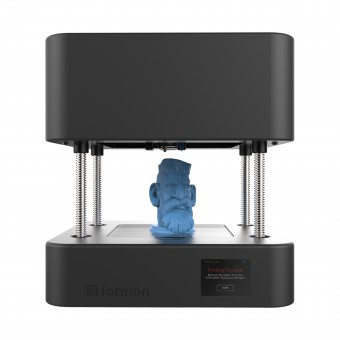 |
|
||||
| DESIGN DETAILS | |||||
| DESIGN NAME: Formon Core PRIMARY FUNCTION: Desktop 3D Printer INSPIRATION: For our team 3d printing was the closest thing to magic that we have ever experienced. You get to create a physical object directly from digital input. With Formon Core we redesigned the whole printing process in order to give users the feeling that it is creating something almost out of thin air. It is designed as a magic box, that opens upwards while printing and revealing the printed object. After the printing is finished, the user can take the object out and the printer gets closed down. UNIQUE PROPERTIES / PROJECT DESCRIPTION: Formon Core is designed for the end user, as a plug-and-play device. The whole approach in the design process was to remove the perceptual barriers from the user’s sight, such as cables, motors and other technical elements. By removing these items, Formon Core is psychologically perceived as simple and easy to use and consequentially understood on how it works. As opposed to the competitors in the market, Formon Core doesn’t look like a factory machine that is not home or office friendly. OPERATION / FLOW / INTERACTION: The user simply loads the 3d file as .stl format in Formon Scope (print preparation software) and positions it in the printing plate, scales it up or down, duplicates it, chooses high, medium or low resolution and clicks the print button. The software automates all the processes behind such as 3d model slicing, melting temperature, material flow rate and print speed. The printer recieves the sliced file and starts printing. PROJECT DURATION AND LOCATION: The project started in March 2014 in Prishtina, Kosovo. |
PRODUCTION / REALIZATION TECHNOLOGY: The enclosures of Formon Core are made of high strength polyurethane plastic, that is one of the best heat resistant plastics. The rounded corners on every edge are used in order to make the product look friendlier and more appropriate for any interior office, and to balance the whole design. It is produced with a standard Reaction Injection Molding. The internal structure is made of a composite material sheet on which all the pulleys, print head, linear guides and other moving mechanical systems are placed. Most of the productions is outsourced abroad, since Kosovo lacks the infrastructure for producing such products. Only the assembly is kept in house. SPECIFICATIONS / TECHNICAL PROPERTIES: Formon Core has a very small footprint of 30 cm x 30 cm x 21.5 cm, with a total print area of 14 cm x 13 cm x 10 cm at a layer resolution of 90 microns (0.09mm). It can connect through Wi-Fi or USB cable, and the user can interact with it through a touch screen display. TAGS: 3d printer, desktop 3d printer, 3d printing, consumer electronics, design, prototyping RESEARCH ABSTRACT: We target professional consumers such as architects, industrial designers and mechanical engineers, people who deal directly with creating physical objects. We went door to door to a lot of architecture and design firms in the region and asked them would they use 3d printing in their design processes, what are the barriers that they face when deciding to purchase a 3d printer. 90% of the interviewed individuals and companies had 2 main barriers, that current 3d printers are expensive and that they are complicated to use. This research lasted 6 months, during which we recorder all the interviews. The other research method was done through spreading an online survey where the same questions as in live interviews were asked. From the survey we aslo got 86% percent of the respondents having the same 2 issues. CHALLENGE: Kosovo is a very small country with a quite undeveloped academia. The biggest challenge was to have access to certain know hows when the production processes were concerned, material selection, electronics design etc. Formon team had to learn most of the things from scratch, spent months on researching on how to choose materials and production processes that are efficient and that bring costs down. The suppliers were chosen online and for every supplier that we have, we negotiated and exchanged a lot of emails with at least 10 or 15 other suppliers that do the same thing. We now have 15 suppliers and had to negotiate with almost 200 suppliers. We had to research every aspect of manufacturing on how to be as efficient as we can. The same happened with logistics, a process that we had to develop from scratch. ADDED DATE: 2016-06-30 16:17:06 TEAM MEMBERS (1) : IMAGE CREDITS: Rron Cena , 2016. |
||||
| Visit the following page to learn more: http://formon3d.com/ | |||||
| AWARD DETAILS | |
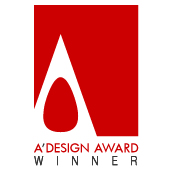 |
Formon Core Desktop 3d Printer by Rron Cena is Winner in Prosumer Products and Workshop Equipment Design Category, 2016 - 2017.· Press Members: Login or Register to request an exclusive interview with Rron Cena . · Click here to register inorder to view the profile and other works by Rron Cena . |
| SOCIAL |
| + Add to Likes / Favorites | Send to My Email | Comment | Testimonials | View Press-Release | Press Kit |
